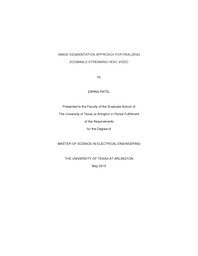
ATTENTION: The works hosted here are being migrated to a new repository that will consolidate resources, improve discoverability, and better show UTA's research impact on the global community. We will update authors as the migration progresses. Please see MavMatrix for more information.
Show simple item record
| dc.contributor.author | Patel, Zarna | en_US |
| dc.date.accessioned | 2015-07-31T22:10:17Z | |
| dc.date.available | 2015-07-31T22:10:17Z | |
| dc.date.submitted | January 2015 | en_US |
| dc.identifier.other | DISS-13157 | en_US |
| dc.identifier.uri | http://hdl.handle.net/10106/25100 | |
| dc.description.abstract | With increasing popularity of high resolution video format, video coding technology such as High Efficiency Video Coding (HEVC) which can provide a substantially higher compression capability than the existing H.264/AVC standard has received increased attention. HEVC is the next generation compression technology lauded as the enabler for a host of new services and capabilities. Recently, multimedia applications and their use have grown dramatically in popularity due to mobile device adoption by the consumer market. However, a crucial challenge is to provide a better user experience for browsing videos on the limited and heterogeneous screen sizes. Streaming of an arbitrary region of interest (ROI) from a high resolution video is essential to supporting cropping and zooming within a video stream. Zooming allows users to view a cropped ROI at a high resolution, in effect, magnifying the ROI. This thesis explores two methods for ROI-based streaming, referring to them as tiled encoding and partial decoding. Tiled encoding partitions video frames into grid of tiles and encodes each tile as an independently decodable stream. In partial decoding, only the ROI and dependence area are decoded. Apart from these, slice structure dependency on tiled encoding was performed for further bandwidth efficiency. In this, how slice structure influences on compressed file size and average data rate that need to be transmitted for requested ROI was presented. These two methods were evaluated in terms of bandwidth efficiency, storage requirements, and computational costs under different video encoding parameters. HM15.0 version reference software for HEVC was used.Simulation results show that larger tiles significantly improve compression efficiency in tiled encoding, but it would lead to higher bandwidth when streaming ROIs due to wasted transmission of bits that do not contribute to the decoding of ROI. Partial decoding results show that the decoding calculation cost was reduced by 40-55% for 32 buffered luma pixels around ROI. Tiled encoding showed optimal decoding calculation cost and bandwidth efficiency for a tile size of 16×16 pixels. Larger slice size increases the bandwidth efficiency (reduces transmission overhead) but would result in lower compression. These results show that 1460 bytes slice structure improved bandwidth efficiency than 64 bytes slice structure. | en_US |
| dc.description.sponsorship | Rao, Kamisetty R. | en_US |
| dc.language.iso | en | en_US |
| dc.publisher | Electrical Engineering | en_US |
| dc.title | Image Segmentation Approach For Realizing Zoomable Streaming HEVC Video | en_US |
| dc.type | M.S. | en_US |
| dc.contributor.committeeChair | Rao, Kamisetty R. | en_US |
| dc.degree.department | Electrical Engineering | en_US |
| dc.degree.discipline | Electrical Engineering | en_US |
| dc.degree.grantor | University of Texas at Arlington | en_US |
| dc.degree.level | masters | en_US |
| dc.degree.name | M.S. | en_US |
Files in this item
- Name:
- Patel_uta_2502M_13157.pdf
- Size:
- 1.809Mb
- Format:
- PDF
This item appears in the following Collection(s)
Show simple item record


